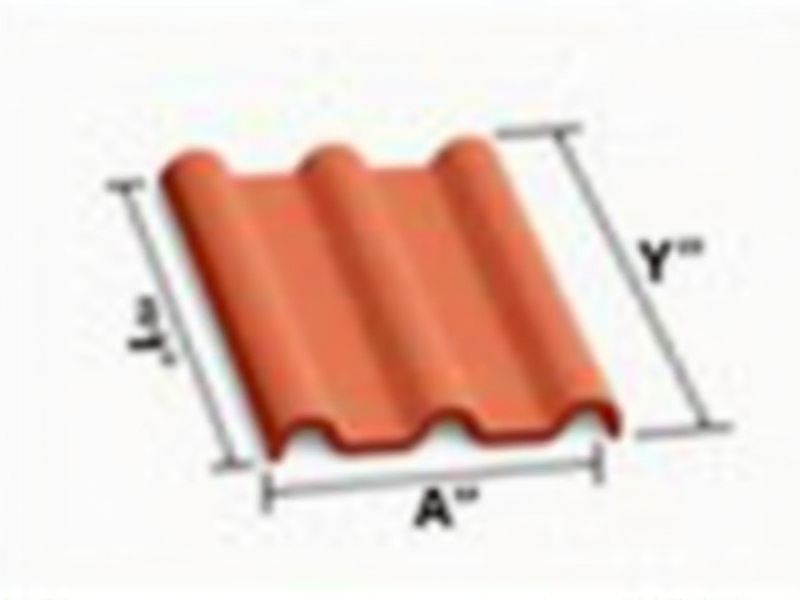
Standard dimensions of roof tiles can vary depending on the material and manufacturer, but many commonly used clay and concrete roof tiles are typically around 16 inches (410 mm) in length and 10 inches (250 mm) in width. Thickness usually ranges from 0.4 to 0.6 inches (10 to 15 mm), providing durability and strength for various weather conditions. Always check with your tile supplier or refer to local building codes, as regional variations and architectural styles may influence the exact size requirements. Ensuring you have the correct dimensions for your project will help with precise planning and minimize material waste during installation.
Length And Width
The standard dimensions for roof tiles typically range from 10 to 16 inches in length and 6 to 12 inches in width, depending on the design and roofing system. For example, a common size for clay tiles is 12 inches by 8 inches, while concrete tiles may measure 14 inches by 10 inches. In terms of coverage, one square (100 square feet) generally requires about 100 to 120 tiles, depending on the overlap and shape of the tiles used. Selecting the right size not only impacts aesthetics but also influences the overall durability and weather resistance of your roofing project.
Thickness
Roof tile thickness typically varies between 5 to 20 millimeters, with a common standard of 10 to 15 millimeters for durability and insulation. A thicker tile can provide better deflection resistance and weather protection, enhancing the overall lifespan of your roofing system. Many manufacturers adhere to strict industry standards, ensuring that tiles meet specific load-bearing and impact resistance metrics. When selecting roof tiles, consider the thickness alongside local climate conditions to ensure optimal performance and longevity.
Overlap Area
The overlap area of roof tiles plays a crucial role in ensuring effective water resistance and durability. Typically, the standard overlap for roof tiles ranges from 2 to 6 inches, depending on the type and manufacturer. This overlap not only affects the aesthetic appearance of the roof but also contributes to its overall structural integrity against wind uplift. You should always consult specific installation guidelines to determine the optimal overlap required for your chosen tile to maximize performance and longevity.
Coverage Per Square Meter
The coverage per square meter for roof tiles typically ranges from 8 to 12 tiles, depending on the tile size and style. For example, a standard clay tile often covers about 10 tiles per square meter, while interlocking tiles may provide enhanced efficiency, covering approximately 11 tiles per square meter. Knowing the specific coverage can significantly impact your roofing project, influencing material costs and overall installation time. Always consult manufacturer guidelines to ensure optimal performance and compliance with local building codes.
Weight
Roof tile weight is a crucial factor in determining both structural integrity and ease of installation. Standard concrete roof tiles typically weigh between 5 to 9 pounds per square foot, while clay tiles can range from 6 to 12 pounds per square foot. Choosing the right weight can significantly influence the overall durability of your roof, as heavier tiles may better withstand harsh weather conditions. Be mindful of your building's support structure to ensure it can accommodate the specific weight of the roof tiles you select.
Material Type
When selecting roof tiles, material type is crucial for durability and performance. Common materials include clay, concrete, slate, and metal, each offering unique benefits. For instance, clay tiles typically last over 50 years, providing excellent insulation, while concrete tiles are known for their affordability and resistance to fire. By understanding your needs and the characteristics of these materials, you can make an informed choice that enhances your home's value and longevity.
Edge Design
Focus on edge design in roof tiles enhances both aesthetic appeal and functional performance. Tiles featuring unique edge profiles can improve water drainage and reduce the risk of leaks, which is crucial for roofs in regions with heavy rainfall. According to industry standards, edge design can contribute to a tile's overall durability, with materials like ceramic or concrete offering lifespans exceeding 50 years. Investing in high-quality edge design not only elevates the visual impact of your roof but also ensures optimal long-term protection against environmental elements.
Surface Texture
Surface texture significantly influences the performance and aesthetics of roof tiles, with varied options including smooth, textured, and ribbed finishes. Textured roof tiles, often retaining more water and resisting moss and algae growth, can extend the lifespan of your roof by up to 30 years. In regions prone to harsh weather conditions, a robust surface texture can enhance durability, offering resistance against wind uplift and thermal expansion. The choice of surface texture not only impacts the functionality but also contributes to the overall visual appeal, allowing for personalized architectural designs that can increase property value by 10-15%.
Color Variations
Roof tiles exhibit a rich diversity in color variations, ranging from traditional earthy tones to modern bold hues. For instance, clay tiles can present shades of terracotta, while concrete tiles often feature a spectrum of gray, black, and even vibrant colors like blue or green. It's important to note that color can influence your home's energy efficiency; lighter shades reflect sunlight better, potentially lowering cooling costs by up to 20%. When selecting roof tiles, consider the color impact on your property's aesthetic appeal and its thermal performance.
Manufacturing Standards
Manufacturing standards for roof tiles ensure durability, water resistance, and thermal efficiency, key attributes in safeguarding homes. High-quality roof tiles often comply with ISO 9001, indicating excellence in quality management systems. According to industry data, clay tiles can last over 100 years, while concrete varieties typically last between 30 to 50 years, depending on maintenance. When selecting tiles, consider the ASTM standards, which provide rigorous testing protocols to verify structural integrity and performance under various environmental conditions.
